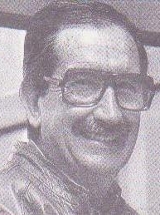U.Porto Memory
University of Porto Famous Alumni
Luís Pádua Ramos
 |
Luís Pádua Ramos 1931-2005 Architect and lecturer |
 Luís Duarte Pádua Ramos was born in Lourenço Marques, nowadays Maputo, in Mozambique, on 22 January 1931, where he complete his primary and part of his secondary education.
Luís Duarte Pádua Ramos was born in Lourenço Marques, nowadays Maputo, in Mozambique, on 22 January 1931, where he complete his primary and part of his secondary education.
He came to Portugal in 1945, and completed his secondary education as a border student, in the now extinct Almeida Garrett College, in Porto.
In 1949, he enrolled in the Porto School of Fine Arts, where he was taught by Masters Carlos Ramos and Júlio Resende and had as fellow colleagues José Rodrigues, Jorge Pinheiro, Ângelo de Sousa and Espiga Pinto.
While he was studying for his degree, he was distinguished with the following prizes: Mota Coelho, from ESBAP (1952), Soares dos Reis Award and the National Academy of Fine Arts Award (1953). He was one of the organizing members of the 1st Magna Exhibition in ESBAP (1952), dedicated to Master Barata Feyo, and participated in the second edition of this event (1953). In 1955, he was invited to collaborate in the architecture office of José Carlos Loureiro.
In 1957, he presented a thesis on solar incidence in architecture and town planning, and completed his degree on 30 March in that same year with full marks.
In 1959, he received the Porto Rotary Club Award and began his professional activity joining one of the teams chosen by the Calouste Gulbenkian Foundation to prepare the draft project for the Foundation’s head-office.
In the following year, he started working as a higher education teacher and was appointed second assistant at ESBAP (Applied Geometry). He was also invited to become the partner of Carlos Loureiro at his architecture office.
He left teaching in 1969 and was totally dedicated to Architecture.
 In 1976, he founded GALP Lda. (Gabinete de Urbanismo, Arquitectura e Engenharia, Lda.) [in the Town Planning, Architecture and Engineering business] with his partner José Carlos Loureiro. This office produced numerous projects, such as the Centro Pastoral Paulo VI, the areas protecting and valuing the Apparitions Chapel and the lay-religious building in the Sanctuary of Fátima. Other projects include the Solverde Hotel, in Granja; the D. Henrique Hotel, in Porto; the renovation of Santo António General Hospital, in Porto, and the Faculty of Sciences of the University of Porto, Campus 3.
In 1976, he founded GALP Lda. (Gabinete de Urbanismo, Arquitectura e Engenharia, Lda.) [in the Town Planning, Architecture and Engineering business] with his partner José Carlos Loureiro. This office produced numerous projects, such as the Centro Pastoral Paulo VI, the areas protecting and valuing the Apparitions Chapel and the lay-religious building in the Sanctuary of Fátima. Other projects include the Solverde Hotel, in Granja; the D. Henrique Hotel, in Porto; the renovation of Santo António General Hospital, in Porto, and the Faculty of Sciences of the University of Porto, Campus 3.
 Besides Architecture, he was also interested in General Art. He designed jewellery and was an eager collector. This passion, manifested since his early years, made him collect hundreds of popular and scholar works of art, by artists and national and international artisans. His most impressing collection, considered to be one of the largest European collections of 15th century to 20th century art, consists of thousands of works of art, such as jewellery, furniture, sculptures, ceramic works and paintings, many of which by famous artists such as Lalique, Tiffany, Braque and Dali.
Besides Architecture, he was also interested in General Art. He designed jewellery and was an eager collector. This passion, manifested since his early years, made him collect hundreds of popular and scholar works of art, by artists and national and international artisans. His most impressing collection, considered to be one of the largest European collections of 15th century to 20th century art, consists of thousands of works of art, such as jewellery, furniture, sculptures, ceramic works and paintings, many of which by famous artists such as Lalique, Tiffany, Braque and Dali.
 He participated regularly in various art exhibitions, in Portugal and abroad, and was one of the founders of Lugar do Desenho, belonging to Júlio Resende.
He participated regularly in various art exhibitions, in Portugal and abroad, and was one of the founders of Lugar do Desenho, belonging to Júlio Resende.
He was married to Maria da Graça, was the father of Luísa Maria, and grandfather of Diogo and Luisinha.
He died at home in Matosinhos, on 19 October 2005, at the age of 74, and was buried in the family tomb at the Senhora da Hora Cemetery, designed by him, which portrays a door designed by his friend and colleague José Rodrigues.
In 2014 the Foundation José Rodrigues, in Porto, presented the exhibition Padua Ramos: 50 years of design 1955: 2005.
(Universidade Digital / Gestão de Informação, 2010)
Last updated: 2016-06-23 Webpage created on: 2025-06-15 12:08:30 Complaint Portal